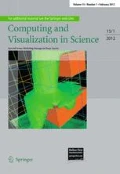Abstract
We present an approach for finding the overlap area between two ellipses that does not rely on proxy curves. The Gauss-Green formula is used to determine a segment area between two points on an ellipse. Overlap between two ellipses is calculated by combining the areas of appropriate segments and polygons in each ellipse. For four of the ten possible orientations of two ellipses, the method requires numerical determination of transverse intersection points. Approximate intersection points can be determined by solving the two implicit ellipse equations simultaneously. Alternative approaches for finding transverse intersection points are available using tools from algebraic geometry, e.g., based on solving an Eigen-problem that is related to companion matrices of the two implicit ellipse curves. Implementations in C of several algorithm options are analyzed for accuracy, precision and robustness with a range of input ellipses.







Similar content being viewed by others
References
Böröczky, K., Reitzner, M.: Approximation of smooth convex bodies by random circumscribed polytopes. Ann. Appl. Prob. 14(1), 239–273 (2004)
Boost The Boost. Polygon Library http://www.boost.org/doc/libs/1_54_0/libs/polygon/doc/index.htm
Busé, L., Khalil, H., Mourrain, B.: Resultant-based methods for plane curves intersection problems. Lecture notes in computer science, pp. 75–92 (2005)
Chraibi, M., Seyfried, A., Schadschneider, A.: Generalized centrifugal force model for pedestrian dynamics. Phys. Rev. E. 82(4), 046111 (2010)
Eberly, D.: The area of intersecting ellipses. Accessed at http://www.geometrictools.com/Documentation/AreaIntersectingEllipses.pdf (2010)
Elkadi, M., Mourrain, B.: Symbolic-numeric tools for solving polynomial equations and applications. In: Dickenstein, A., Emiris, I. (eds.) Solving Polynomial Equations: Foundations, Algorithms, and Applications, vol. 14 of Algorithms and Computation in Mathematics, pp. 125–168. Springer, Berlin (2005)
Etayo, F., Gonzalez-Vega, L., Del Rio, N.: A new approach to characterizing the relative position of two ellipses depending on one parameter. Comput. Aided Geom. Des. 23(4), 324–350 (2006)
Fu, P., Walton, O.R., Harvey, J.T.: Polyarc discrete element for efficiently simulating arbitrarily shaped 2D particles. Int. J. Numer. Methods Eng. 89(5), 599–617 (2012)
Gruber, P.M.: Asymptotic estimates for best and stepwise approximation of convex bodies IV. Forum Math. 10, 665–686 (1998)
Han, K., Feng, Y.T., Owen, D.R.J.: Polygon-based contact resolution for superquadrics. Int. J. Numer. Methods Eng. 66, 485–501 (2006)
Ludwig, M.: Asymptotic approximation of convex curves. Arch. Math. 63, 377–384 (1994)
Manocha, D., Demmel, J.: Algorithms for intersecting parametric and algebraic curves I: simple intersections. ACM Transactions on Graphics (TOG) 13(1), 73–100 (1994)
Mcnamee, J.M.: A 2002 update of the supplementary bibliography on roots of polynomials. J. Comput. Appl. Math. 142(2), 433–434 (2002)
Nonweiler, T.R.F.: CACM Algorithm 326: Roots of low order polynomials. Communications of the ACM. 11, 4, 269–270. Translated into C and programmed by M. Dow, ANUSF, Australian National University, Canberra, Australia. Accessed at http://www.netlib.org/toms/326 (1968)
Pan, V.Y.: Univariate polynomials: nearly optimal algorithms for numerical factorization and root-finding. J. Symb. Comput. 00, 1–33 (2002)
Pan, V.Y.: Solving a polynomial equation: some history and recent progress. SIAM Rev. 39(2), 187–220 (1997)
Press, W.H., Flannery, B.P., Teukolsky, S.A., Vetterling, W.T.: Numerical Recipes: the Art of Scientific Computing. Cambridge University Press, New York (1992)
Steiner, A., Buckley, A.: GSL Extension for solving quartic polynomials with gsl\_poly\_complex\_solve. Accessed at http://www.network-theory.co.uk/download/gslextras/Quartic/ (2004)
Zeng, Z.: Algorithm 835. ACM Trans. Math. Softw. 30(2), 218–236 (2004)
Author information
Authors and Affiliations
Corresponding author
Additional information
Communicated by: Gabriel Wittum.
Rights and permissions
About this article
Cite this article
Hughes, G.B., Chraibi, M. Calculating ellipse overlap areas. Comput. Visual Sci. 15, 291–301 (2012). https://doi.org/10.1007/s00791-013-0214-3
Received:
Accepted:
Published:
Issue Date:
DOI: https://doi.org/10.1007/s00791-013-0214-3




